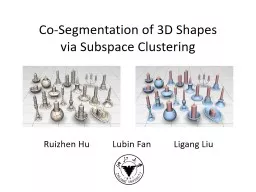PPT-Universal Properties of Shapes
Author : yoshiko-marsland | Published Date : 2016-10-06
Bell ringer Write down as many 3dimensional shapes as you can in 60 seconds What did you get Shapes in biology What shape is a human Shapes in biology What shape
Presentation Embed Code
Download Presentation
Download Presentation The PPT/PDF document "Universal Properties of Shapes" is the property of its rightful owner. Permission is granted to download and print the materials on this website for personal, non-commercial use only, and to display it on your personal computer provided you do not modify the materials and that you retain all copyright notices contained in the materials. By downloading content from our website, you accept the terms of this agreement.
Universal Properties of Shapes: Transcript
Bell ringer Write down as many 3dimensional shapes as you can in 60 seconds What did you get Shapes in biology What shape is a human Shapes in biology What shape is a dog Shapes in biology. The filter building block together with an external clock and a few resistors can produce various second order functions The filter building block has 3 output pins One of the output pins can be configured to perform highpass all pass or notch funct Rechelle Mojica. Dr. Mari Guillermo. San Diego Miramar College. San Diego State University – Interwork Institute. Universal Design =. “The design of products and environments to be usable by all people without the need for adaptation or specialized design”. Yu Chen, Tae-. K. yun. Kim, Roberto . Cipolla. Department of Engineering. University of Cambridge. Roadmap. Brief Introductions. Our Framework. Experimental Results. Summary. Motivation. +. 3D Shapes. Make a tangram by drawing an 8 x 8 square and cutting out the 7 shapes as shown below.. Tangrams: making shapes. Use all 7 shapes each time; they can be rotated and flipped over if needed.. Individual pieces must not overlap each other. . Exploring Structural Engineering Fundamentals. Shapes in Bridges. Shapes in Buildings. Shapes in Other Things!. Relative Strength of Shapes. On your paper, sketch what you think will happen to these shapes if we apply the force shown in . Project 3: August 27, 28, 31. Underlying Shapes. Day 1: Warm Up. In your sketch / notebook, write “Underlying Shapes” at the top of the page.. Draw a horizontal line in the middle of the page.. with the Wandering Spanish Omelette. Hello. I am the Wandering Spanish Omelette, and I really love…. Shapes. 形状. …especially…. The circle. 圆形. The square. 正方形. The triangle. 三角形. Properties of Shapes. Number of sides. Number of angles. Number of lines of symmetry. Regular or irregular. Right Angles. Parallel lines. Shapes. Quadrilaterals. Triangles. Polygons. Key Words. Regular Shapes. . Inland. COMO Lew Wargo. CQEC (9ER). 24 JAN 2016. NAV RULES< LIGHTS & SHAPES. REFERENCE. Navigation Rules. International - Inland. COMDTINST M16672.2(series). . LIGHTS AND SHAPES. Navigation lights must be displayed:. DRILL: . GET IPAD AND MIRROR!. What . shapes. could you use to draw lips?. What shapes are . your lips. ? Describe them. Which is bigger/ fuller?. Where is the . via Subspace Clustering. Ruizhen. Hu . Lubin. Fan . Ligang. Liu. Co-segmentation. Hu et al.. Co-Segmentation of 3D Shapes via Subspace Clustering. 2. Input. Co-segmentation. Hu et al.. kindly visit us at www.nexancourse.com. Prepare your certification exams with real time Certification Questions & Answers verified by experienced professionals! We make your certification journey easier as we provide you learning materials to help you to pass your exams from the first try. kindly visit us at www.nexancourse.com. Prepare your certification exams with real time Certification Questions & Answers verified by experienced professionals! We make your certification journey easier as we provide you learning materials to help you to pass your exams from the first try. kindly visit us at www.nexancourse.com. Prepare your certification exams with real time Certification Questions & Answers verified by experienced professionals! We make your certification journey easier as we provide you learning materials to help you to pass your exams from the first try.
Download Document
Here is the link to download the presentation.
"Universal Properties of Shapes"The content belongs to its owner. You may download and print it for personal use, without modification, and keep all copyright notices. By downloading, you agree to these terms.
Related Documents














